 W
WAetosauroides is an extinct genus of aetosaur from the Late Triassic of South America. It is one of four aetosaurs known from South America, the others being Neoaetosauroides, Chilenosuchus and Aetobarbakinoides. Three species have been named: the type species A. scagliai, A. subsulcatus and A. inhamandensis. Fossils have been found in the Cancha de Bochas Member of the Ischigualasto Formation in the Ischigualasto-Villa Unión Basin in northwestern Argentina and the Santa Maria Formation in the Paraná Basin in southeastern Brazil. The strata date to the late Carnian and early Norian stages, making Aetosauroides one of the oldest aetosaurs.
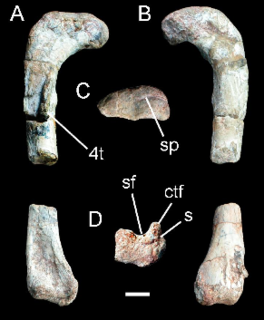 W
WAlwalkeria is a genus of basal saurischian dinosaur from the Late Triassic, living in India. It was a small bipedal omnivore.
 W
WArctosaurus is an extinct genus of archosauromorph, possibly an allokotosaurian, but was often classified as a sauropodomorph dinosaur in the years to follow. Although it has also been classified as a theropod, recent review finds that the similarities it shares with theropods are spread throughout several groups of Late Triassic reptiles, and so it cannot be assigned any more specifically than to Archosauriformes. Other authors have suggested trilophosaurian affinities. Based on the size of the vertebra, a size of about 1.5 metres (4.9 ft) in length is extrapolated.
 W
WBuriolestes is a genus of early sauropodomorph dinosaurs from the Late Triassic Santa Maria Formation of the Paraná Basin in southern Brazil. It contains a single species, B. schultzi, named in 2016. The type specimen was found alongside a specimen of the lagerpetid dinosauromorph Ixalerpeton.
 W
WChiniquodon is an extinct genus of carnivorous cynodonts, which lived during the Late Triassic (Carnian) in South America and Africa. Chiniquodon is closely related to a contemporary genus, Probelesodon, and close to the ancestry of mammals.
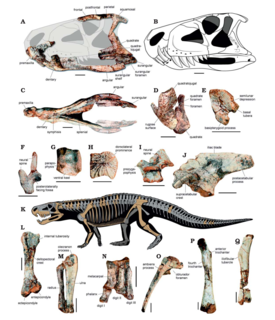 W
WDynamosuchus is an extinct genus of pseudosuchian archosaurs from the family Ornithosuchidae. It is known from a single species, Dynamosuchus collisensis, which is based on a partial skeleton from the Santa Maria Formation of Brazil. Dynamosuchus is considered a close relative of Venaticosuchus, which is known from the Ischigualasto Formation of Argentina. Ornithosuchids are one of many groups which lived in the Santa Maria and Ischigualasto Formations, which formed at approximately the same time and were ecologically similar. As a large scavenging reptile, Dynamosuchus helps to illuminate the trophic structure of the Santa Maria Formation. It also supports the hypothesis that ornithosuchids had diversified throughout South America by the start of the Carnian, and were not originally endemic to the Ischigualasto-Villa Unión Basin.
 W
WEcteninion is an extinct genus of meat-eating cynodonts that lived during the Late Triassic (Carnian) in South America. The type species Ecteninion lunensis was named by R.N. Martinez, C.L. May, and C.A. Forster in 1996. E. lunensis is known from a nearly complete skull of about 11 centimetres (4.3 in) in length. It was found in the Cancha de Bochas Member of the Ischigualasto Formation in the Ischigualasto-Villa Unión Basin in northwestern Argentina. It has been interpreted as a basal eucynodont. The holotype is in the collection of the Universidad Nacional de San Juan.
 W
WEodromaeus was an extinct genus of probable basal theropod dinosaurs from the Late Triassic of Argentina. Like many other of the earliest-known dinosaurs, it hails from the Carnian-age Ischigualasto Formation, within the Ischigualasto-Villa Unión Basin of northwestern Argentina. Upon its discovery, it was argued to be one of the oldest true theropods, supplanting its contemporary Eoraptor, which was reinterpreted as a basal sauropodomorph.
 W
WEoraptor is a genus of small, lightly-built, basal saurischian dinosaur. One of the earliest-known dinosaurs, it lived approximately 231 to 228 million years ago, during the Late Triassic in Western Gondwana, in the region that is now northwestern Argentina. The type and only species, Eoraptor lunensis, was first described in 1993, and is known from several well-preserved skeletons. Eoraptor had heterodont dentition, which suggests that it was omnivorous.
 W
WEubrachiosaurus is an extinct genus of stahleckeriine dicynodont known from the Late Triassic of Wyoming, United States.
 W
WEucnemesaurus is a basal sauropodomorph dinosaur genus usually considered to be a synonym of Euskelosaurus. Recent study by Yates (2006), however, indicates that it is valid and the same animal as putative "giant herrerasaurid" Aliwalia.
 W
WGigatitan is an extinct genus of titanopteran insect that lived in Kyrgyzstan during the Triassic period. The type species is G. vulgaris, described by Aleksandr Grigorevich Sharov in 1968. Fossils of Gigatitan have been found in the Madygen Formation. In life, Gigatitan was a mantis-like predator with a wingspan of approximately 33 centimetres (13 in). Its forelimbs were similarly enlarged and bore spines for prey capture. The ovipositor of Gigatitan bore sharp cutting ridges. These were likely used to excise holes in plant matter for oviposition, similar to some modern Orthoptera. It is the type genus of the family Gigatitanidae, in which the closely related Nanotitan and Ootitan are also included.
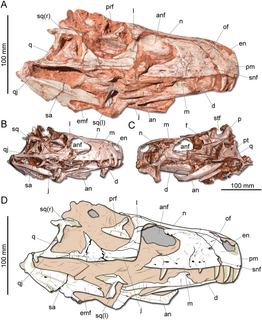 W
WGnathovorax is a genus of herrerasaurid saurischian dinosaur from the Santa Maria Formation in Rio Grande do Sul, Brazil. The type and only species is Gnathovorax cabreirai, described by Pacheco et al. in 2019.
 W
WHerrerasaurus was a genus of saurischian dinosaur from the Late Triassic period. This genus was one of the earliest dinosaurs from the fossil record. Its name means "Herrera's lizard", after the rancher who discovered the first specimen in 1958 in South America. All known fossils of this carnivore have been discovered in the Ischigualasto Formation of Carnian age in northwestern Argentina. The type species, Herrerasaurus ischigualastensis, was described by Osvaldo Reig in 1963 and is the only species assigned to the genus. Ischisaurus and Frenguellisaurus are synonyms.
 W
WHyperodapedon is a genus of rhynchosaurs from the Late Triassic period. Fossils of the genus have been found in Africa, Asia, Europe and North and South America. Its first discovery and naming was found by Thomas Henry Huxley in 1859. Hyperodapedon was a herbivore that used its beaked premaxilla and hindlimbs to dig for plants in dry land.
 W
WIgnotosaurus is an extinct genus of silesaurid dinosauriform known from the Late Triassic (Carnian) Cancha de Bochas Member of the Ischigualasto Formation in the Ischigualasto-Villa Unión Basin in northwestern Argentina. It was therefore contemporary with early dinosaurs such as Herrerasaurus, and lived in the same place.
 W
WIrajatherium is an extinct genus of cynodonts, known only of the type species Irajatherium hernandezi. It is named in honor of Irajá Damiani Pinto.
 W
WIschigualastia is an extinct genus of dicynodonts, that lived during the Carnian age of the Late Triassic Period. The genus was found in and named after the Ischigualasto Formation of the Ischigualasto-Villa Unión Basin in northwestern Argentina. It has been placed in the family Stahleckeriidae.
 W
WLongisquama is a genus of extinct reptile. There is only one species, Longisquama insignis, known from a poorly preserved skeleton and several incomplete fossil impressions from the Middle to Late Triassic Madygen Formation in Kyrgyzstan. It is known from a type fossil specimen, slab and counterslab and five referred specimens of possible integumentary appendages. All specimens are in the collection of the Paleontological Institute of the Russian Academy of Sciences in Moscow.
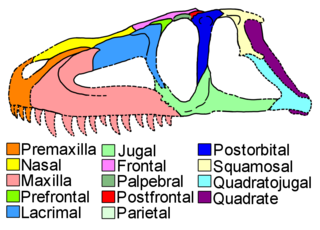 W
WLuperosuchus is an extinct genus of loricatan pseudosuchian reptile which contains only a single species, Luperosuchus fractus. It is known from the Chañares Formation of Argentina, within strata belonging to the latest Ladinian stage of the late Middle Triassic, or the earliest Carnian of the Late Triassic. Luperosuchus was one of the largest carnivores of the Chañares Formation, although its remains are fragmentary and primarily represented by a skull with similarities to Prestosuchus and Saurosuchus.
 W
WMadygenerpeton is an extinct genus of chroniosuchid reptiliomorph from middle and upper Triassic deposits of Madygen Formation of Kyrgyzstan. It was first named by paleontologists Rainer R. Schoch, Sebastian Voigt and Michael Buchwitz in 2010 from a nearly complete skull and associated osteoderms. The type species is M. pustulatus.
 W
WMoghreberia is an extinct genus of dicynodont from the Late Triassic (Carnian) Timezgadiouine Formation of Morocco.
 W
WNhandumirim is a genus of saurischian dinosaur from the Carnian age of Late Triassic Brazil. The type and only species, Nhandumirim waldsangae, is known from a single immature specimen including vertebrae, a chevron, pelvic material, and a hindlimb found in the Santa Maria Formation in Rio Grande do Sul. Nhandumirim is differentiated from other Santa Maria dinosaurs such as Staurikosaurus and Saturnalia on the basis of its more gracile, long-legged proportions and several more specific skeletal features. It also possessed several unique features compared to other early dinosaurs, such as long keels on vertebrae at the base of the tail, a straight metatarsal IV, and a short brevis fossa of the ilium and dorsolateral trochanter of the femur. Several features of the tibia led the describers of the genus and species to consider Nhandumirim waldsangae the earliest theropod, but some analyses offer alternative positions within Saurischia.
 W
WPanphagia is a genus of sauropodomorph dinosaur described in 2009. It lived around 231 million years ago, during the Carnian age of the Late Triassic period in what is now northwestern Argentina. Fossils of the genus were found in the La Peña Member of the Ischigualasto Formation in the Ischigualasto-Villa Unión Basin. The name Panphagia comes from the Greek words pan, meaning "all", and phagein, meaning "to eat", in reference to its inferred omnivorous diet. Panphagia is one of the earliest known dinosaurs, and is an important find which may mark the transition of diet in early sauropodomorph dinosaurs.
 W
WPelorocephalus is an extinct genus of chigutisaurid temnospondyls from the Late Triassic (Carnian) Cacheutá Formation of the Cuyo Basin and the Ischigualasto Formation of the Ischigualasto-Villa Unión Basin, both in northwestern Argentina. Three species are currently recognized: the type species C. mendozensis, which was named in 1944, P. tenax, which was named in 1949 as a species of Chigutisaurus and reassigned to Pelorocephalus in 1999, and P. cacheutensis, which was named in 1953 as another species of Chigutisaurus and reassigned to Pelorocephalus along with P. tenax. A fourth species, P. ischigualastensis, was named in 1975 after the formation it was found in. The species P. tunuyanensis was named in 1948 but has since been synonymized with P. mendozensis. The largest individuals are estimated to have been over 107 centimetres (42 in) in length.
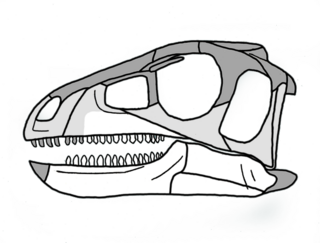 W
WPisanosaurus is an extinct genus of primitive dinosauriform that lived approximately 228 to 216 million years ago during the latter part of the Triassic Period in what is now South America. It was a small, lightly-built, ground-dwelling herbivore, that could grow up to an estimated 1 m (3.3 ft) long. Only one species, the type, Pisanosaurus mertii, is known, based on a single partial skeleton discovered in the Ischigualasto Formation of the Ischigualasto-Villa Unión Basin in northwestern Argentina.
 W
WPlacerias is an extinct genus of dicynodonts that lived during the late Carnian age of the Triassic Period. Placerias belongs to a group of dicynodonts called Kannemeyeriiformes, which was the last known group of dicynodonts before dicynodonts became extinct at the end of the Triassic.
 W
WProbainognathus meaning “progressive jaw” is an extinct genus of cynodonts that lived around 235 to 221.5 million years ago, during the Late Triassic in what is now South America. Probainognathus is a member of the family Probainognathidae, and is a close relative of the family Chiniquodontidae. The various similarities to Chiniquodontidae led Alfred Romer to initially suggest Probainognathus be placed within that family, but it was subsequently decided that the differences were enough to warrant its placement within Probainognathidae.
 W
WProterochampsa is a genus of proterochampsid archosauromorph from the Late Triassic (Carnian) Cancha de Bochas Member of the Ischigualasto Formation in the Ischigualasto-Villa Unión Basin in northwestern Argentina and the Alemoa Member of the Santa Maria Formation in the Paraná Basin in southeastern Brazil. It normally measured about 1.8 to 2 m, though P. barrionuevoi, known from a 44 centimetres (17 in) skull, could have grown up to 3.5 m (11 ft).
 W
WPseudochampsa is an extinct genus of proterochampsid archosauriform known from the Late Triassic (Carnian) Cancha de Bochas Member of the Ischigualasto Formation of San Juan Province, Ischigualasto-Villa Unión Basin in northwestern Argentina. It contains a single species, Pseudochampsa ischigualastensis, originally named as a second species of the closely related Chanaresuchus, based on a fairly complete articulated skeleton and skull. A revision of the remains concluded that it was best to move to species to its own genus, as no traits were found to unite P. ischigualastensis and the type species of Chanaresuchus to the exclusion of other proterochampsids. A phylogenetic analysis places both species in a polytomy with Gualosuchus as the most advanced members of Proterochampsia.
 W
WPtychoceratodus is an extinct genus of prehistoric sarcopterygians or lobe-finned fish originally named as a species of Ceratodus in 1837. It was a lungfish from the Mesozoic era (Triassic-Cretaceous), and the only members of the family Ptychoceratodontidae. One species, P. oldhami, was named in 2018 based on remains from the Carnian-aged Tiki Formation (India). The first named species, which is also the type species, is P. phillipsi, which was named in 1837 by Louis Agassiz as a species of Ceratodus and moved to a separate genus in 1926.
 W
WRhynchosaurs were a group of Triassic diapsid reptiles from the group Archosauromorpha, meaning they were distantly related to the archosaurs.
 W
WRiograndia is an extinct genus of tritheledontid cynodonts from the Late Triassic of South America. The type and only species is Riograndia guaibensis. Remains have been found in the Caturrita Formation of the geopark of Paleorrota. It was a small non-mammalian cynodont several advanced features also present in mammals. Several specimens of Riograndia guaibensis have been found in the towns of Candelária and Faxinal do Soturno in the Caturrita Formation. The genus defines the Riograndia Assemblage Zone.
 W
WSanjuansaurus is a genus of herrerasaurid dinosaur from the Late Triassic (Carnian) Cancha de Bochas and La Peña Members of the Ischigualasto Formation of the Ischigualasto-Villa Unión Basin in northwestern Argentina.
 W
WSaurosuchus is a genus of large loricatan pseudosuchian archosaur that lived in South America during the Late Triassic period. It was a heavy, ground-dwelling, quadrupedal carnivore, being the major predator in the Ischigualasto Formation.
 W
WScleromochlus is an extinct genus of small archosauriform from the Late Triassic period. The genus contains the type and only species Scleromochlus taylori, named by Arthur Smith Woodward in 1907.
 W
WSharovipteryx, is a genus of early gliding reptiles containing the single species Sharovipteryx mirabilis. It is known from a single fossil and is the only glider with a membrane surrounding the pelvis instead of the pectoral girdle. This lizard-like reptile was found in 1965 in the Madygen Formation, Dzailauchou, on the southwest edge of the Fergana valley in Kyrgyzstan, in what was then the Asian part of the U.S.S.R. dating to the middle-late Triassic period. The Madygen horizon displays flora that put it in the Upper Triassic. An unusual reptile, Longisquama, was also found there.
 W
WSillosuchus is a genus of shuvosaurid poposaurid archosaur that lived in South America during the Late Triassic period. Shuvosaurids were an unusual family of reptiles belonging to the group Poposauroidea; although their closest modern relatives are crocodilians, they were bipedal and lightly armored, with dinosaur-like hip and skull structures. Based on skull remains from members of the family such as Effigia, they were also toothless and likely beaked herbivores.
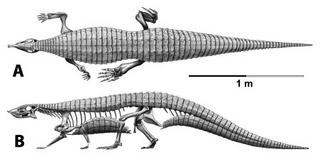 W
WStagonolepis is an extinct genus of stagonolepidid aetosaur known from the Late Triassic Hassberge Formation of Germany, the Drawno Beds of Poland, the Lossiemouth Sandstone of Scotland, the Chinle Formation of Arizona and Utah and the Bluewater Creek Formation of New Mexico.
 W
WTanystropheus, was a 6-meter-long (20 ft) reptile that dated from the Middle to Late Triassic epochs. It is recognizable by its extremely elongated neck, which measured 3 m (9.8 ft) long—longer than its body and tail combined. The neck was composed of 12–13 extremely elongated vertebrae. With its very long but relatively stiff neck, Tanystropheus has been often proposed and reconstructed as an aquatic or semi-aquatic reptile, a theory supported by the fact that the creature is most commonly found in semi-aquatic fossil sites wherein known terrestrial reptile remains are scarce. Fossils have been found in Europe. Complete skeletons of small individuals are common in the Besano Formation at Monte San Giorgio in Italy and Switzerland; other fossils have been found in the Middle East and China, dating from the Middle Triassic to the early part of the Late Triassic.
 W
WThalattosaurus meaning "sea lizard," from the Attic Greek thalatta (θάλαττα), "sea," and sauros (σαῦρος), "lizard," is an extinct genus of marine reptile in the family Thalattosauroidea. They were aquatic diapsids that are known exclusively from the Triassic period. It was a 2 metres (6.6 ft) long shellfish-eating reptile with paddle-like limbs and a down-turned rostrum occurring in the Lower and Middle Triassic Sulphur Mountain Formation of British Columbia as well as the Upper Triassic Hosselkus Limestone of California. It has gained notoriety as a result of studies on general diapsid phylogeny.
 W
WTrialestes is an extinct genus of Late Triassic (Carnian) crocodylomorphs that lived in South America. It has been classified as a dinosaur in the past due it being adapted as a terrestrial, running carnivore. It is classified in Sphenosuchia, which were early relatives of crocodylians. Irmis, Nesbitt and Sues (2013) noted that some of the material referred to this taxon is actually dinosaurian; however, according to the authors, the holotype specimen PVL 2561, found in the Cancha de Bochas Member of the Ischigualasto Formation in the Ischigualasto-Villa Unión Basin in northwestern Argentina, "comprises a single individual that preserves unambiguous crocodylomorph synapomorphies", indicating it is indeed a crocodylomorph, and one of the referred specimens, PVL 3889, does share one or more autapomorphies with the holotype, indicating it represents the same taxon. The type species, T. romeri, was named in 1963.
 W
WVenaticosuchus is a genus of pseudosuchian archosaurs from the family Ornithosuchidae. Known from a single species, Venaticosuchus rusconii, this genus is described based on an incomplete skull and jaw collected from the Late Triassic (Carnian) Ischigualasto Formation in the Ischigualasto-Villa Unión Basin in northwestern Argentina, which was deposited around 230 million years ago. This fossil material has been termed the holotype specimen PVL 2578. Venaticosuchus incorporated a myriad of features present in the other two genera of ornithosuchids, Ornithosuchus and Riojasuchus. However, it also had several unique traits, relating to the lower jaw.